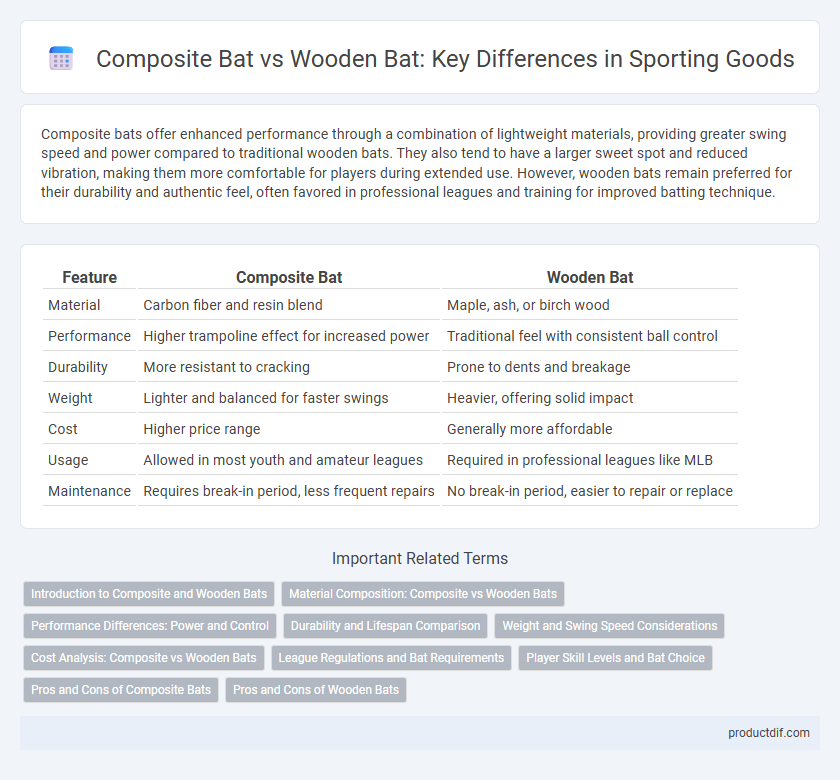Composite bats offer enhanced performance through a combination of lightweight materials, providing greater swing speed and power compared to traditional wooden bats. They also tend to have a larger sweet spot and reduced vibration, making them more comfortable for players during extended use. However, wooden bats remain preferred for their durability and authentic feel, often favored in professional leagues and training for improved batting technique.
Table of Comparison
| Feature | Composite Bat | Wooden Bat |
|---|---|---|
| Material | Carbon fiber and resin blend | Maple, ash, or birch wood |
| Performance | Higher trampoline effect for increased power | Traditional feel with consistent ball control |
| Durability | More resistant to cracking | Prone to dents and breakage |
| Weight | Lighter and balanced for faster swings | Heavier, offering solid impact |
| Cost | Higher price range | Generally more affordable |
| Usage | Allowed in most youth and amateur leagues | Required in professional leagues like MLB |
| Maintenance | Requires break-in period, less frequent repairs | No break-in period, easier to repair or replace |
Introduction to Composite and Wooden Bats
Composite bats feature a layered construction of carbon fiber, fiberglass, and resin, offering enhanced durability and improved performance through greater flex and larger sweet spots. Wooden bats, traditionally crafted from ash, maple, or birch, provide a classic feel and balanced weight distribution favored for their natural pop and sound on contact. Understanding the materials and design differences is essential for athletes aiming to select the optimal bat for power, control, and league regulations.
Material Composition: Composite vs Wooden Bats
Composite bats are constructed using a blend of carbon fiber, fiberglass, and resin, offering enhanced durability, reduced weight, and improved flexibility compared to traditional wooden bats made from ash, maple, or birch. The composite material provides a larger sweet spot and better vibration dampening, resulting in increased power and comfort during gameplay. Wooden bats, while heavier and less forgiving, are preferred for their natural feel and consistent performance, but they tend to have a shorter lifespan due to susceptibility to cracks and dents.
Performance Differences: Power and Control
Composite bats deliver enhanced power due to their lightweight design and larger sweet spots, allowing players to generate higher bat speed and greater ball exit velocity. Wooden bats offer superior control and a more consistent feel with every swing, providing better feedback and precision for skilled hitters. The choice between composite and wooden bats ultimately hinges on a player's preference for power-driven performance or tactile control.
Durability and Lifespan Comparison
Composite bats typically offer superior durability compared to wooden bats due to their advanced materials like carbon fiber and fiberglass, which resist cracking and warping. Wooden bats, while favored for their traditional feel and performance, tend to have a shorter lifespan because they are prone to splintering and breaking under high-impact use. The lifespan of composite bats often extends several seasons, whereas wooden bats may need frequent replacement after a few games.
Weight and Swing Speed Considerations
Composite bats typically weigh less than wooden bats, allowing players to achieve faster swing speeds and greater control during play. The lighter weight of composite bats reduces fatigue, enabling more consistent performance over multiple at-bats. Wooden bats, while heavier, provide a solid feel and more feedback at impact, but their increased weight often results in a slower swing speed compared to composite models.
Cost Analysis: Composite vs Wooden Bats
Composite bats typically have a higher upfront cost, ranging from $150 to $500, due to advanced materials and technology used in their construction. Wooden bats, often priced between $40 and $150, offer a more budget-friendly option but require frequent replacements as they break more easily. Over time, the durability and performance benefits of composite bats can offset the initial investment, making them cost-effective for serious players.
League Regulations and Bat Requirements
League regulations for baseball often mandate specific bat materials, with many youth and amateur leagues permitting only wooden bats to meet safety and performance standards. Composite bats, made from advanced carbon fiber and resin materials, may be restricted or banned in certain leagues due to their enhanced durability and ball exit speeds, which can impact fair play. Bat requirements typically include specifications on bat length, weight, and barrel diameter to ensure standardized equipment and player safety across all levels of competition.
Player Skill Levels and Bat Choice
Composite bats offer enhanced performance features such as larger sweet spots and reduced vibration, making them ideal for players seeking improved power and comfort, especially at higher skill levels. Wooden bats provide a traditional feel and better control, preferred by professional and skilled players who emphasize precision and bat-to-ball feedback. Selecting between composite and wooden bats depends largely on a player's skill development stage and specific performance needs.
Pros and Cons of Composite Bats
Composite bats offer enhanced performance with a lighter weight and larger sweet spot, allowing players to swing faster and generate more power. They tend to have better vibration dampening, reducing sting on the hands compared to wooden bats, but often come at a higher cost and may have durability concerns under extreme conditions. These bats require a break-in period before optimal performance, unlike wooden bats which are game-ready immediately.
Pros and Cons of Wooden Bats
Wooden bats offer superior feedback and durability due to their solid construction, enhancing player control and swing accuracy. However, they tend to be heavier and less forgiving on mishits compared to composite bats, potentially reducing swing speed and increasing the risk of breakage. Despite these drawbacks, wooden bats are preferred in many professional leagues for their traditional feel and balanced performance.
Composite bat vs Wooden bat Infographic

 productdif.com
productdif.com